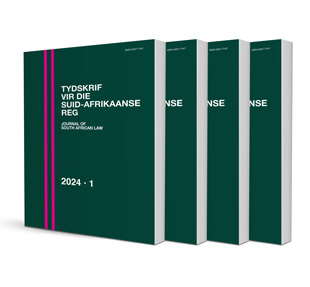
Regspraak: Struikel en val op ongelyke loopvlakke – ’n tydige waarskuwing om katvoet te loop op plaveistene
Author: J Scott
ISSN: 1996-2207
Affiliations: Universiteit van Suid-Afrika
Source: Tydskrif vir die Suid-Afrikaanse Reg, Issue 3, 2024, p. 563-580
https://doi.org/10.47348/TSAR/2024/i3a9
Abstract
Our case law is rife with judgments dealing with delictual claims instituted by those who had suffered harm due to a fall on a slippery or an uneven surface. Most of these cases dealt with the question whether the owner or occupier of the area in which the plaintiff sustained injury had failed to take precautions to protect those, who walked over the floors, or along the walkways or roads over which such owner or occupier had control, against potential harm due to a potential danger lurking in the walking surface, such as spilt liquid on a supermarket floor or a hole in a sidewalk. Proving the elements of wrongfulness and negligence have usually been the focal point of a plaintiff’s claim in these cases. Regarding the wrongfulness element, the problematic area of liability for an omission unwaveringly raises its head.
Of primary significance in this regard is one of the factors usually considered in establishing whether an omission which does not usually attract liability is in fact actionable, viz control over a dangerous object.
In the case under discussion the plaintiff was injured when she tripped and fell on an uneven paved walkway on her way from a parking area at a shopping centre to a shop (Food Lover’s Market (FLM)). She claimed damages from FLM as well as from a trust, the lessee of the shopping mall premises. The court dealt in some detail with the question of the wrongfulness of an omission, concluding that FLM owed the plaintiff no legal duty to keep premises on the outside of its shop in a safe condition. Further regarding the possible liability due to a breach of a legal duty by FLM and the trust, it was found that although the evidence had shown that portions of the paving of walkways in and around the shopping centre were uneven, this did not constitute an unusual dangerous situation to pedestrians and, furthermore, that it cannot be expected that those in control of such walkways should keep them in a permanent pristine condition. The court therefore found no wrongful omissions on the part of the defendants. It also found no negligence on their part. In the course of its treatment of the element of wrongfulness and even (unnecessarily) negligence, the court unfortunately failed in several respects to render a jurisprudentially sound clarification of the nature and application of the relevant principles.
In the final analysis the plaintiff failed because she could not adduce sufficient evidence to convince the court to find that the defendants had breached any legal duty owed to her. Had the claim against FLM been allowed, it would have amounted to a significant extension of the duties of property owners and occupiers, leading to unnecessary uncertainty and the possibility of indeterminate liability.